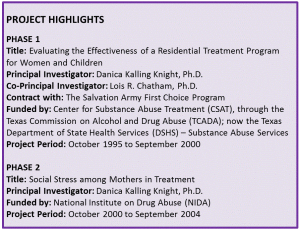
The focus of the Women and Children Project was to evaluate the effectiveness of treatment services provided to substance abusing women and their dependent children at the Salvation Army’s First Choice Program in Fort Worth. Women entering this 12-month residential program lived with their children in small apartments on the First Choice campus and participated in a comprehensive treatment program. They received individual, group, and family therapy, special assistance in relapse prevention, nutrition, and vocational training, and were connected with a variety of local agencies designed to assist them in securing housing, employment, and health care following graduation from the program. Children also received special services and were integrated into the treatment program through special activities, play therapy, and family therapy. Child care was provided for children younger than school age.
The original research project, funded by the Center for Substance Abuse Treatment (CSAT), focused on evaluating services provided by the agency and examining individual, family, and treatment-related factors that impact substance abuse problems and facilitate recovery. During the period between April 1996 and September 2000, a variety of data collection instruments were administered at intake, regular intervals during treatment, and follow-up interviews were conducted at 6 and 12 months after discharge. Evaluation of treatment services included documenting the type and intensity of services received by women and children, and evaluating the effectiveness of several specialized interventions, including a specially developed IBR module entitled Partners in Parenting.
The project yielded useful information about women and children as they enter treatment. Alcohol and crack/cocaine were the primary drugs of choice among these women. A large percentage had psychosocial problems and nearly all reported a history of victimization.
Approximately half of the children also had a history of victimization and a large percentage exhibited behavior problems. A study of social relationships documented significant positive change in family relationships during the first 3 months of treatment, and even greater change among peer relationships during that period, particularly with regard to deviance and the development of supportive relationships with fellow residents. Other studies examining factors related to treatment participation indicated that various aspects of social relationships differentially impact treatment retention and completion. Specifically, clients with a greater number of children in treatment and those with a lack of partner support were more likely to leave treatment prematurely. Additionally, clients reporting higher levels of social deviance (i.e., recent arrests, association with deviant peers) were less likely to complete treatment requirements.
In an effort to more fully explore the role of social relationships in women’s treatment engagement and recovery, the women and children’s project was extended through September, 2004. Funds from NIDA enabled us to examine the impact of women’s social systems on their ability to engage in and profit from treatment. Changes in social networks, the inability to fulfill responsibilities in various roles, and a lack of support from family members and peers, were used to define a measure of “social stress.”
2005 Related Training Activities
In April, Danica Knight presented Parent training using Partners in Parenting and Partners in Parenting: Skill enhancements for parents in treatment at the Parenting Skills Symposium, co-sponsored by the Clinical Trials Network Mid-Atlantic Node, Mid-Atlantic ATTC, and Central East ATTC, Baltimore, MD.
Norma Bartholomew conducted Trainer training for Partners in Parenting in June at the Washington Department of Corrections, Tacoma, WA.
Selected Publications
Knight, D. K., Bartholomew, N. G., & Simpson, D. D. (2007). An exploratory study of “Partners in Parenting” within two substance abuse treatment programs for women. Psychological Services, 4(4), 262-276. [Abstract]
Hood., P., Knight, D. K., & Logan, S. M. (2003). Mutually beneficial collaboration: Using evaluation to improve service delivery. Lessons learned: Residential substance abuse treatment for women and their children (DHHS Publication No. SMA 03-3787). Rockville, MD: Center for Substance Abuse Treatment.
Knight, D. K., & Wallace, G. (2003). Where are the children? An examination of children’s living arrangements when mothers enter residential drug treatment. Journal of Drug Issues, 33(2), 305-324. [Abstract]
Knight, D. K., Logan, S. M., & Simpson, D. D. (2001). Predictors of program completion for women in residential substance abuse treatment. American Journal of Drug and Alcohol Abuse, 27(1), 1-18. [Abstract]
Knight, D. K., Wallace, G. L., Joe, G. W., & Logan, S. M. (2001). Change in psychosocial functioning and social relations among women in residential substance abuse treatment. Journal of Substance Abuse, 13(4), 533-547. [Abstract]
Bartholomew, N. G., Knight, D. K., Chatham, L. R., & Simpson, D. D. (2000). Partners for Parenting: A DATAR/First Choice treatment manual. Fort Worth: Texas Christian University, Institute of Behavioral Research.
Knight, D. K., Hood, P. E., Logan, S. M., & Chatham, L. R. (1999). Residential treatment for women with dependent child: One agency’s approach. Journal of Psychoactive Drugs, 31(4), 339-351. [Abstract]